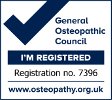The prescription and use of foot orthotics is controversial but, from my clinical experience and recent research, I have found that they ease the symptoms resultant of a number of different structural problems such as altered foot mechanics and leg length discrepancies. Slowly introducing made-to-measure foot orthotics (insoles) can often correct structural imbalances throughout the body.
Many people seek treatment from Osteopaths for symptoms arising from the lower back, pelvic and sacro-iliac region or the knees. There are many possible causes for the aches and pains in these areas however, in quite a number of cases, the problem often originate from an underlying leg length difference (affecting between 70 – 90% of the population). Leg length differences can occur due to structural reasons such as pronation (rolling in) of the medial arch of the foot or other foot imbalances or actual physical differences in the length of the bones of the legs (for example, shortening of a bone can occur due to a fracture). They can also be due to functional reasons such as altered muscular mechanics of the legs (for example, tightening of the ilio-psoas hip flexor muscle on one side).
Both structural and functional changes in leg length affect not only the foot mechanics but also the functionality of the knees, pelvis and the spine. There is the belief that such leg length differences and altered foot mechanics can even be the cause of debilitating headaches in some patients.
Walking with a pronated foot forces most of the body weight to the inner border of the foot. As the person walks, the pronated foot arch collapses to various degrees which can force the knee of that leg to roll inwards which increases the ‘Q angle’ and causes strain to the structures of the knee. In turn, the pelvis rolls forward on the same side which results in torsion in the pelvis. This can lead to spinal lateral curves called scoliosis and low back pain. The only way to rectify the situation is to provide the necessary support using custom-made orthotics.
In the case of knee pain due to foot pronation, treating locally may alleviate the problem in the short term but it needs to be addressed using foot orthotics if long term relief is to be achieved. This is where Osteopathy treats ‘the body as a unit’ (one of the main principles of Osteopathy) rather than taking a more reductionist view.







